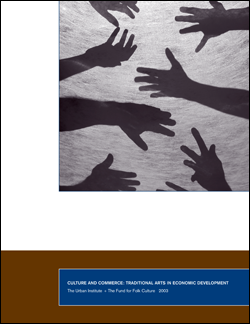Culture and Commerce
Traditional Arts in Economic Development
2003, 52 pages. Fund for Folk Culture, P.O. Box 1566, Santa Fe, NM 87504-1566, 505-984-2534, www.folkculture.org; Urban Institute, 2100 M Street, N.W., Washington DC 20037, 202-833-7200, www.urban.org.
Download:
![]() Culture and Commerce (1.5Mb)
Culture and Commerce (1.5Mb)
Culture and Commerce: Traditional Arts in Economic Development presents information on collaborations between representatives of the non-profit and for-profit sectors. A program initiated by the Fund for Folk Culture paired organizations representing the traditional arts with economic development organizations in order to foster the growth and economic viability of the traditional arts. This study analyzes the results of these collaborations.
Often, the interests of traditional arts and economic developers do not merge into a productive partnership. This initiative intended to show both groups the value that traditional arts can bring to the marketplace and eco¬nomic development. While new market relationships were not generated from these collaborations, the study did find potential for long-term partnerships between traditional arts organizations and economic developers.
The results of this study can be used in similar projects to inform participants from both culture and com-merce. All types of arts organizations and all types of economic institutions will find this study helpful in plan¬ning for developing markets, in connecting markets to promotion efforts, and in incorporating the arts into regional planning efforts.
Eight of the year-long projects funded by this initiative were reviewed for this study. Positive results included building the business skills of artisans and arts organizations, solidifying community bonds, educating youth about traditional arts, and showing the value of the arts in the marketplace. However, not all communities had the economic tools to promote and assist the arts organizations in fully utilizing the marketplace. Many of the partnerships were on the brink of forming a solid success, but hadn't reached it yet. With the addition of follow-up support some of the missing tools could be supplied.
Critical resources are needed to en¬sure that collaborations such as these continue and prosper. Business development resources, such as micro-entrepreneurship programs, are not always available, particularly outside urban areas. Intermediaries who can advocate for the value of the arts are also extremely helpful in promoting a long-term relationship between economic developers and arts organizations. These tools are essential to creating a synergy between arts and economic interests.
Included in the study are descriptions of the funded collaborations. Each pairing is presented objectively with information about the contributions and assets of the partnership, as well as about the challenges and liabilities each one faces. The wide variety of projects and partnerships gives an excellent sense of the possibilities for any arts-economic partnering.
This study provides a strong case for connecting traditional arts with economic interests. In addition to the potential financial gains for an organization, collaborations can also build stronger communities and contribute to regional growth. This report states that, while in principle the interests and capabilities of traditional arts and economic development pair up well, the reality does not always provide the best result. Therefore, better tools need to be developed and offered in more communities.
Culture and Commerce is an informative report that provides good insights into the relationship between non-profit and for-profit organizations. It offers solid conclusions and suggestions and would be a useful tool for any arts organization contemplating a partnership with a for-profit entity.

